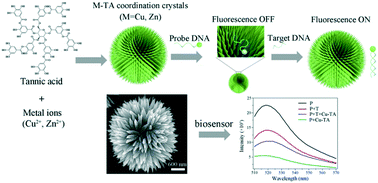Synthesis of spiny metal–phenolic coordination crystals as a sensing platform for sequence-specific detection of nucleic acids†
Abstract
Spiny metal–phenolic coordination crystals are synthesized using a nontoxic plant polyphenol as a ligand. Due to the abundance of metal species and sp2-hybridized carbon atoms on their spiny surface, such coordination crystals can adsorb DNA probes and quench the fluorescence, resulting in a high efficiency for nucleic acid assay.

- This article is part of the themed collection: Editor’s Collection: Bio-applications of MOFs


 Please wait while we load your content...
Please wait while we load your content...